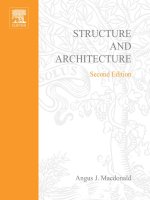Structure and Architecture potx
Bạn đang xem bản rút gọn của tài liệu. Xem và tải ngay bản đầy đủ của tài liệu tại đây (5.91 MB, 167 trang )
Structure and Architecture
This Page Intentionally Left Blank
Structure and Architecture
Angus J. Macdonald
Department of Architecture, University of Edinburgh
Second edition
Architectural Press
OXFORD AUCKLAND BOSTON JOHANNESBURG MELBOURNE NEW DELHI
Structure and Architecture
Architectural Press
An imprint of Butterworth-Heinemann
Linacre House, Jordan Hill, Oxford OX2 8DP
225 Wildwood Avenue, Woburn, MA 01801-2041
A division of Reed Educational and Professional Publishing Ltd
A member of the Reed Elsevier plc group
First published 1994
Reprinted 1995, 1996, 1997
Second edition 2001
© Reed Educational and Professional Publishing Ltd 1994, 2001
All rights reserved. No part of this publication
may be reproduced in any material form (including
photocopying or storing in any medium by electronic
means and whether or not transiently or incidentally
to some other use of this publication) without the
written permission of the copyright holder except
in accordance with the provisions of the Copyright,
Designs and Patents Act 1988 or under the terms of a
licence issued by the Copyright Licensing Agency Ltd,
90 Tottenham Court Road, London, England W1P 0LP.
Applications for the copyright holder’s written permission
to reproduce any part of this publication should be addressed
to the publishers
British Library Cataloguing in Publication Data
Macdonald, Angus J.
Structure and architecture. – 2nd ed.
1. Structural design. 2. Architectural design
I. Title
721
ISBN 0 7506 4793 0
Library of Congress Cataloguing in Publication Data
A catalogue record for this book is available from the Library of Congress
Printed and bound in Great Britain
Composition by Scribe Design, Gillingham, Kent
Preface vii
Acknowledgements ix
Introduction xi
1 The relationship of structure to building 1
2 Structural requirements 9
2.1 Introduction 9
2.2 Equilibrium 9
2.3 Geometric stability 9
2.4 Strength and rigidity 15
2.5 Conclusion 21
3 Structural materials 22
3.1 Introduction 22
3.2 Masonry 22
3.3 Timber 25
3.4 Steel 30
3.5 Concrete 35
4 The relationship between structural form
and structural efficiency 37
4.1 Introduction 37
4.2 The effect of form on internal
force type 37
4.3 The concept of ‘improved’ shapes in
cross-section and longitudinal
profile 40
4.4 Classification of structural elements 45
5 Complete structural arrangements 47
5.1 Introduction 47
5.2 Post-and-beam structures 48
5.3 Semi-form-active structures 55
5.4 Form-active structures 57
5.5 Conclusion 59
6 The critical appraisal of structures 60
6.1 Introduction 60
6.2 Complexity and efficiency in structural
design 60
6.3 Reading a building as a structural
object 67
6.4 Conclusion 71
7 Structure and architecture 73
7.1 Introduction 73
7.2 The types of relationship between
structure and architecture 73
7.3 The relationship between architects
and engineers 114
Selected bibliography 124
Appendix 1: Simple two-dimensional force
systems and static equilibrium 128
A1.1 Introduction 128
A1.2 Force vectors and resultants 128
A1.3 Resolution of a force into
components 129
A1.4 Moments of forces 129
A1.5 Static equilibrium and the equations
of equilibrium 129
A1.6 The ‘free-body-diagram’ 132
A1.7 The ‘imaginary cut’ technique 132
Appendix 2: Stress and strain 134
A2.1 Introduction 134
A2.2 Calculation of axial stress 135
A2.3 Calculation of bending stress 135
A2.4 Strain 138
Appendix 3: The concept of statical
determinacy 140
A3.1 Introduction 140
A3.2 The characteristics of statically
determinate and statically
indeterminate structures 140
A3.3 Design considerations in relation to
statical determinacy 146
Index 149
Contents
This Page Intentionally Left Blank
The major theme of this book is the
relationship between structural design and
architectural design. The various aspects of
this are brought together in the last chapter
which has been expanded in this second
edition, partly in response to comments from
readers of the first edition, partly because my
own ideas have changed and developed, and
partly as a consequence of discussion of the
issues with colleagues in architecture and
structural engineering. I have also added a
section on the types of relationship which have
existed between architects, builders and
engineers, and on the influence which these
have had on architectural style and form. The
penultimate chapter, on structural criticism,
has also been extensively rewritten. It is hoped
that the ideas explored in both of these
chapters will contribute to the better
understanding of the essential and
undervalued contribution of structural
engineering to the Western architectural
tradition and to present-day practice.
Angus J. Macdonald
Department of Architecture,
University of Edinburgh
December 2000
vii
Preface to the
second edition
This Page Intentionally Left Blank
Angus Macdonald would like to thank all
those, too numerous to mention, who have
assisted in the making of this book. Special
thanks are due to Stephen Gibson for his
carefully crafted line drawings, Hilary Norman
for her intelligent design, Thérèse Duriez for
picture research and the staff of Architectural
Press (and previously Butterworth-Heinemann)
for their hard work and patience in initiating,
editing and producing the book, particularly
Neil Warnock-Smith, Diane Chandler, Angela
Leopard, Siân Cryer and Sue Hamilton.
Illustrations other than those commissioned
specially for the book are individually credited
in their captions. Thanks are due to all those
who supplied illustrations and especially to
Pat Hunt, Tony Hunt, the late Alastair Hunter,
Jill Hunter and the staff of the picture libraries
of Ove Arup & Partners, Anthony Hunt
Associates, the British Cement Association, the
Architectural Association, the British
Architecture Library and the Courtauld
Institute.
Thanks are also due most particularly to
my wife Pat, for her continued
encouragement and for her expert scrutiny of
the typescript.
ix
Acknowledgements
This Page Intentionally Left Blank
It has long been recognised that an
appreciation of the role of structure is
essential to the understanding of architecture.
It was Vitruvius, writing at the time of the
founding of the Roman Empire, who identified
the three basic components of architecture as
firmitas, utilitas and venustas and Sir Henry
Wooton, in the seventeenth century
1
, who
translated these as ‘firmness’, ‘commodity’ and
‘delight’. Subsequent theorists have proposed
different systems by which buildings may be
analysed, their qualities discussed and their
meanings understood but the Vitruvian
breakdown nevertheless still provides a valid
basis for the examination and criticism of a
building.
‘Commodity’, which is perhaps the most
obvious of the Vitruvian qualities to
appreciate, refers to the practical functioning
of the building; the requirement that the set of
spaces which is provided is actually useful and
serves the purpose for which the building was
intended. ‘Delight’ is the term for the effect of
the building on the aesthetic sensibilities of
those who come into contact with it. It may
arise from one or more of a number of factors.
The symbolic meanings of the chosen forms,
the aesthetic qualities of the shapes, textures
and colours, the elegance with which the
various practical and programmatic problems
posed by the building have been solved, and
the ways in which links have been made
between the different aspects of the design are
all possible generators of ‘delight’.
‘Firmness’ is the most basic quality. It is
concerned with the ability of the building to
preserve its physical integrity and survive in
the world as a physical object. The part of the
building which satisfies the need for ‘firmness’
is the structure. Structure is fundamental:
without structure there is no building and
therefore no ‘commodity’. Without well-
designed structure there can be no ‘delight’.
To appreciate fully the qualities of a work of
architecture the critic or observer should
therefore know something of its structural
make-up. This requires an intuitive ability to
read a building as a structural object, a skill
which depends on a knowledge of the
functional requirements of structure and an
ability to distinguish between the structural
and the non-structural parts of the building.
The first of these attributes can only be
acquired by systematic study of those branches
of mechanical science which are concerned
with statics, equilibrium and the properties of
materials. The second depends on a knowledge
of buildings and how they are constructed.
These topics are reviewed briefly in the
preliminary chapters of this book.
The form of a structural armature is
inevitably very closely related to that of the
building which it supports, and the act of
designing a building – of determining its
overall form – is therefore also an act of
structural design. The relationship between
structural design and architectural design can
take many forms however. At one extreme it is
possible for an architect virtually to ignore
structural considerations while inventing the
form of a building and to conceal entirely the
structural elements in the completed version
of the building. The Statue of Liberty (Fig. ii) at
the entrance to New York harbour, which, given
that it contains an internal circulation system
xi
Introduction
1 Wooton, H., The Elements of Architecture, 1624.
of stairs and elevators, can be considered to be
a building, is an example of this type. The
buildings of early twentieth-century
expressionism, such as the Einstein Tower at
Potsdam by Mendelsohn (Fig. iii) and some
recent buildings based on the ideas of
Deconstruction (see Figs 1.11 and 7.41 to 7.44)
might be cited as further examples.
All of these buildings contain a structure,
but the technical requirements of the structure
have not significantly influenced the form
which has been adopted and the structural
elements themselves are not important
contributors to the aesthetics of the
architecture. At the other extreme it is possible
to produce a building which consists of little
other than structure. The Olympic Stadium in
Munich (Fig. i), by the architects Behnisch and
Partners with Frei Otto, is an example of this.
Between these extremes many different
approaches to the relationship between
structure and architecture are possible. In the
‘high tech’ architecture of the 1980s (Fig. iv), for
example, the structural elements discipline the
plan and general arrangement of the building
and form an important part of the visual
vocabulary. In the early Modern buildings of
Gropius, Mies van der Rohe, Le Corbusier (see
Fig. 7.34) and others, the forms which were
adopted were greatly influenced by the types of
geometry which were suitable for steel and
reinforced concrete structural frameworks.
Introduction
xii
Fig. i Olympic
Stadium, Munich,
Germany, 1968–72;
Behnisch & Partner,
architects, with Frei
Otto. In both the canopy
and the raked seating
most of what is seen is
structural. (Photo: A.
Macdonald)
The relationship between structure and
architecture can therefore take many forms and
it is the purpose of this book to explore these
against a background of information concerning
the technical properties and requirements of
structures. The author hopes that it will be
found useful by architectural critics and
historians as well as students and practitioners
of the professions concerned with building.
xiii
Introduction
Fig. iv Inmos
Microprocessor Factory,
Newport, South Wales,
1982; Richard Rogers
Partnership, architects;
Anthony Hunt
Associates, structural
engineers. The general
arrangement and
appearance of this
building were strongly
influenced by the
requirements of the
exposed structure. The
form of the latter was
determined by space-
planning requirements.
(Photo: Anthony Hunt
Associates)
Fig. ii The thin external surface of the
Statue of Liberty in New York Harbour, USA,
is supported by a triangulated structural
framework. The influence of structural
considerations on the final version of the
form was minimal.
Fig. iii Sketches by
Mendelsohn of the
Einstein Tower,
Potsdam, Germany,
1917. Structural
requirements had little
influence on the external
form of this building,
although they did affect
the internal planning.
Surprisingly, it was
constructed in
loadbearing masonry.
This Page Intentionally Left Blank
The simplest way of describing the function of
an architectural structure is to say that it is the
part of a building which resists the loads that
are imposed on it. A building may be regarded
as simply an envelope which encloses and
subdivides space in order to create a protected
environment. The surfaces which form the
envelope, that is the walls, the floors and the
roof of the building, are subjected to various
types of loading: external surfaces are exposed
to the climatic loads of snow, wind and rain;
floors are subjected to the gravitational loads
of the occupants and their effects; and most of
the surfaces also have to carry their own
weight (Fig. 1.1). All of these loads tend to
distort the building envelope and to cause it to
collapse; it is to prevent this from happening
that a structure is provided. The function of a
structure may be summed up, therefore, as
being to supply the strength and rigidity which
are required to prevent a building from
collapsing. More precisely, it is the part of a
building which conducts the loads which are
imposed on it from the points where they arise
to the ground underneath the building, where
they can ultimately be resisted.
The location of the structure within a
building is not always obvious because the
structure can be integrated with the non-
structural parts in various ways. Sometimes, as
in the simple example of an igloo (Fig. 1.2), in
which ice blocks form a self-supporting
protective dome, the structure and the space
enclosing elements are one and the same
thing. Sometimes the structural and space-
enclosing elements are entirely separate. A
very simple example is the tepee (Fig. 1.3), in
which the protecting envelope is a skin of
fabric or hide which has insufficient rigidity to
form an enclosure by itself and which is
supported on a framework of timber poles.
Complete separation of structure and envelope
occurs here: the envelope is entirely non-
structural and the poles have a purely
structural function.
The CNIT exhibition Hall in Paris (Fig. 1.4) is
a sophisticated version of the igloo; the
reinforced concrete shell which forms the main
element of this enclosure is self-supporting
and, therefore, structural. Separation of skin
and structure occurs in the transparent walls,
however, where the glass envelope is
supported on a structure of mullions. The
chapel by Le Corbusier at Ronchamp (see Fig.
7.40) is a similar example. The highly
1
Chapter 1
The relationship of
structure to building
Fig. 1.1 Loads on the building envelope. Gravitational
loads due to snow and to the occupation of the building
cause roof and floor structures to bend and induce
compressive internal forces in walls. Wind causes pressure
and suction loads to act on all external surfaces.
sculptured walls and roof of this building are
made from a combination of masonry and
reinforced concrete and are self-supporting.
They are at the same time the elements which
define the enclosure and the structural
elements which give it the ability to maintain
its form and resist load. The very large ice
hockey arena at Yale by Saarinen (see Fig. 7.18)
is yet another similar example. Here the
building envelope consists of a network of
steel cables which are suspended between
three reinforced concrete arches, one in the
vertical plane forming the spine of the building
and two side arches almost in the horizontal
plane. The composition of this building is
more complex than in the previous cases
because the suspended envelope can be
broken down into the cable network, which has
a purely structural function, and a non-
structural cladding system. It might also be
argued that the arches have a purely structural
function and do not contribute directly to the
enclosure of space.
The steel-frame warehouse by Foster
Associates at Thamesmead, UK (Fig. 1.5), is
almost a direct equivalent of the tepee. The
elements which form it are either purely
structural or entirely non-structural because
Structure and Architecture
2
Fig. 1.2 The igloo is a self-supporting compressive envelope.
Fig. 1.3 In the tepee a non-structural skin is supported
on a structural framework of timber poles.
Fig. 1.4 Exhibition Hall of the CNIT, Paris, France; Nicolas Esquillan, architect. The principal element is a self-
supporting reinforced concrete shell.
the corrugated sheet metal skin is entirely
supported by the steel frame, which has a
purely structural function. A similar breakdown
may be seen in later buildings by the same
architects, such as the Sainsbury Centre for the
Visual Arts at Norwich and the warehouse and
showroom for the Renault car company at
Swindon (see Fig. 3.19).
In most buildings the relationship between
the envelope and the structure is more
complicated than in the above examples, and
frequently this is because the interior of the
building is subdivided to a greater extent by
internal walls and floors. For instance, in
Foster Associates’ building for Willis, Faber
and Dumas, Ipswich, UK (Figs 1.6 and 7.37),
3
The relationship of structure to building
Fig. 1.5 Modern art glass warehouse, Thamesmead, UK, 1973; Foster Associates, architects; Anthony Hunt Associates,
structural engineers. A non-structural skin of profiled metal sheeting is supported on a steel framework, which has a
purely structural function. (Photo: Andrew Mead)
the reinforced concrete structure of floor slabs
and columns may be thought of as having a
dual function. The columns are purely
structural, although they do punctuate the
interior spaces and are space-dividing
elements, to some extent. The floors are both
structural and space-dividing elements. Here,
however, the situation is complicated by the
fact that the structural floor slabs are topped
by non-structural floor finishing materials and
have ceilings suspended underneath them. The
floor finishes and ceilings could be regarded as
the true space-defining elements and the slab
itself as having a purely structural function.
The glass walls of the building are entirely
non-structural and have a space-enclosing
function only. The more recent Carré d’Art
building in Nîmes (Fig. 1.7), also by Foster
Associates, has a similar disposition of parts.
As at Willis, Faber and Dumas a multi-storey
reinforced concrete structure supports an
external non-loadbearing skin.
Structure and Architecture
4
Fig. 1.6 Willis, Faber and Dumas Office, Ipswich, UK,
1974; Foster Associates, architects; Anthony Hunt
Associates, structural engineers. The basic structure of
this building is a series of reinforced concrete coffered
slab floors supported on a grid of columns. The external
walls are of glass and are non-structural. In the finished
building the floor slabs are visible only at the perimeter.
Elsewhere they are concealed by floor finishes and a false
ceiling.
Fig. 1.7 Carré d’Art, Nîmes, France, 1993; Foster
Associates, architects. A superb example of late twentieth-
century Modernism. It has a reinforced concrete frame
structure which supports a non-loadbearing external skin
of glass. (Photo: James H. Morris)
The Antigone building at Montpellier by
Ricardo Bofill (Fig. 1.8) is also supported by a
multi-storey reinforced concrete framework.
The facade here consists of a mixture of in situ
and pre-cast concrete elements, and this, like
the glass walls of the Willis, Faber and Dumas
building, relies on a structural framework of
columns and floor slabs for support. Although
this building appears to be much more solid
than those with fully glazed external walls it
was constructed in a similar way. The Ulm
Exhibition and Assembly Building by Richard
Meier (Fig. 1.9) is also supported by a
reinforced concrete structure. Here the
structural continuity (see Appendix 3) and
mouldability which concrete offers were
exploited to create a complex juxtaposition of
solid and void. The building is of the same
basic type as those by Foster and Bofill
however; a structural framework of reinforced
concrete supports cladding elements which are
non-structural.
In the Centre Pompidou in Paris by Piano
and Rogers, a multi-storey steel framework is
used to support reinforced concrete floors and
non-loadbearing glass walls. The breakdown of
5
The relationship of structure to building
Fig. 1.8 Antigone, Montpellier, France, 1983; Ricardo
Bofill, architect. This building is supported by a reinforced
concrete framework. The exterior walls are a combination
of in situ and pre-cast concrete. They carry their own weight
but rely on the interior framework for lateral support.
(Photo: A. Macdonald)
Fig. 1.9 Ulm Exhibition and Assembly Building,
Germany, 1986–93: Richard Meier & Partners, architects.
The mouldability of concrete and the structural continuity
which is a feature of this material are exploited here to
produce a complex juxtaposition of solid and void.
(Photo: E. & F. McLachlan)
parts is straightforward (Fig. 1.10): identical
plane-frames, consisting of long steel columns
which rise through the entire height of the
building supporting triangulated girders at
each floor level, are placed parallel to each
other to form a rectangular plan. The concrete
floors span between the triangulated girders.
Additional small cast-steel girders project
beyond the line of columns (Fig. 7.7) and are
used to support stairs, escalators and servicing
components positioned along the sides of the
building outside the glass wall, which is
attached to the frame near the columns. A
system of cross-bracing on the sides of the
framework prevents it from collapsing through
instability.
The controlled disorder of the rooftop office
extension in Vienna by Coop Himmelblau (Fig.
1.11) is in some respects a complete contrast
to the controlled order of the Centre
Pompidou. Architecturally it is quite different,
expressing chaos rather than order, but
structurally it is similar as the light external
envelope is supported on a skeletal metal
framework.
The house with masonry walls and timber
floor and roof structures is a traditional form of
building in most parts of the world. It is found in
many forms, from the historic grand houses of
the European landed aristocracy (Fig. 1.12) to
modern homes in the UK (Figs 1.13 and 1.14).
Even the simplest versions of this form of
masonry and timber building (Fig. 1.13) are fairly
complex assemblies of elements. Initial
Structure and Architecture
Fig. 1.10 Centre Pompidou, Paris, France, 1977; Piano &
Rogers, architects; Ove Arup & Partners, structural
engineers. The separation of structural and enclosing
functions into distinct elements is obvious here. (Photo: A.
Macdonald)
Fig. 1.11 Rooftop office in Vienna, Austria, 1988; Coop
Himmelblau, architects. The forms chosen here have no
structural logic and were determined with almost no
consideration for technical requirements. This approach
design is quite feasible in the present day so long as the
building is not too large.
6
7
The relationship of structure to building
Fig. 1.12 Château de Chambord, France, 1519–47. One of the grandest domestic buildings in Europe, the Château de
Chambord has a loadbearing masonry structure. Most of the walls are structural; the floors are either of timber or vaulted
masonry and the roof structure is of timber. (Photo: P. & A. Macdonald)
Fig. 1.13 Traditional construction in the
UK, in its twentieth-century form, with
loadbearing masonry walls and timber
floor and roof structures. All structural
elements are enclosed in non-structural
finishing materials.
consideration could result in a straightforward
breakdown of parts with the masonry walls and
timber floors being regarded as having both
structural and space-dividing functions and the
roof as consisting of a combination of the purely
supportive trusses, which are the structural
elements, and the purely protective, non-
structural skin. Closer examination would reveal
that most of the major elements can in fact be
subdivided into parts which are either purely
structural or entirely non-structural. The floors,
for example, normally consist of an inner core of
timber joists and floor boarding, which are the
structural elements, enclosed by ceiling and floor
finishes. The latter are the non-structural
elements which are seen to divide the space. A
similar breakdown is possible for the walls and in
fact very little of what is visible in the traditional
house is structural, as most of the structural
elements are covered by non-structural finishes.
To sum up, these few examples of very
different building types demonstrate that all
buildings contain a structure, the function of
which is to support the building envelope by
conducting the forces which are applied to it
from the points where they arise in the
building to the ground below it where they
are ultimately resisted. Sometimes the
structure is indistinguishable from the
enclosing and space-dividing building
envelope, sometimes it is entirely separate
from it; most often there is a mixture of
elements with structural, non-structural and
combined functions. In all cases the form of
the structure is very closely related to that of
the building taken as a whole and the
elegance with which the structure fulfils its
function is something which affects the
quality of the architecture.
Structure and Architecture
8
Fig. 1.14 Local authority housing, Haddington, Scotland,
1974; J. A. W. Grant, architects. These buildings have
loadbearing masonry walls and timber floor and roof
structures. (Photo: Alastair Hunter)
2.1 Introduction
To perform its function of supporting a
building in response to whatever loads may be
applied to it, a structure must possess four
properties: it must be capable of achieving a
state of equilibrium, it must be stable, it must
have adequate strength and it must have
adequate rigidity. The meanings of these terms
are explained in this chapter. The influence of
structural requirements on the forms which are
adopted for structures is also discussed. The
treatment is presented in a non-mathematical
way and the definitions which are given are not
those of the theoretical physicist; they are
simply statements which are sufficiently
precise to allow the significance of the
concepts to structural design to be
appreciated.
2.2 Equilibrium
Structures must be capable of achieving a
state of equilibrium under the action of
applied load. This requires that the internal
configuration of the structure together with
the means by which it is connected to its
foundations must be such that all applied
loads are balanced exactly by reactions
generated at its foundations. The
wheelbarrow provides a simple demonstration
of the principles involved. When the
wheelbarrow is at rest it is in a state of static
equilibrium. The gravitational forces
generated by its self weight and that of its
contents act vertically downwards and are
exactly balanced by reacting forces acting at
the wheel and other supports. When a
horizontal force is applied to the wheelbarrow
by its operator it moves horizontally and is
not therefore in a state of static equilibrium.
This occurs because the interface between the
wheelbarrow and the ground is incapable of
generating horizontal reacting forces. The
wheelbarrow is both a structure and a
machine: it is a structure under the action of
gravitational load and a machine under the
action of horizontal load.
Despite the famous statement by one
celebrated commentator, buildings are not
machines
1
. Architectural structures must,
therefore, be capable of achieving equilibrium
under all directions of load.
2.3 Geometric stability
Geometric stability is the property which
preserves the geometry of a structure and
allows its elements to act together to resist
load. The distinction between stability and
equilibrium is illustrated by the framework
shown in Fig. 2.1 which is capable of achieving
a state of equilibrium under the action of
gravitational load. The equilibrium is not
stable, however, because the frame will
collapse if disturbed laterally
2
.
9
Chapter 2
Structural requirements
1 ‘A house is a machine for living.’ Le Corbusier.
2 Stability can also be distinguished from strength or
rigidity, because even if the elements of a structure
have sufficient strength and rigidity to sustain the
loads which are imposed on them, it is still possible
for the system as a whole to fail due to its being
geometrically unstable as is demonstrated in
Fig. 2.1.
This simple arrangement demonstrates
that the critical factor, so far as the stability
of any system is concerned, is the effect on it
of a small disturbance. In the context of
structures this is shown very simply in Fig. 2.2
by the comparison of tensile and compressive
elements. If the alignment of either of these is
disturbed, the tensile element is pulled back
into line following the removal of the
disturbing agency but the compressive
element, once its initially perfect alignment
has been altered, progresses to an entirely
new position. The fundamental issue of
stability is demonstrated here, which is that
stable systems revert to their original state
following a slight disturbance whereas unstable
systems progress to an entirely new state.
The parts of structures which tend to be
unstable are the ones in which compressive
forces act and these parts must therefore be
given special attention when the geometric
stability of an arrangement is being
considered. The columns in a simple
rectangular framework are examples of this
(Fig. 2.1). The three-dimensional bridge
structure of Fig. 2.3 illustrates another
potentially unstable system. Compression
occurs in the horizontal elements in the upper
parts of this frame when the weight of an
object crossing the bridge is carried. The
arrangement would fail by instability when this
load was applied due to inadequate restraint
of these compression parts. The compressive
internal forces, which would inevitably occur
Structure and Architecture
10
Fig. 2.1 A rectangular frame with four hinges is capable
of achieving a state of equilibrium but is unstable because
any slight lateral disturbance to the columns will induce it
to collapse. The frame on the right here is stabilised by the
diagonal element which makes no direct contribution to
the resistance of the gravitational load.
Fig. 2.2 The tensile
element on the left here is
stable because the loads
pull it back into line
following a disturbance. The
compressive element on
the right is fundamentally
unstable.
Original alignment
Fig. 2.3 The horizontal
elements in the tops of
the bridge girders are
subjected to
compressive internal
force when the load is
applied. The system is
unstable and any
eccentricity which is
present initially causes
an instability-type
failure to develop.
Compression
Tension









